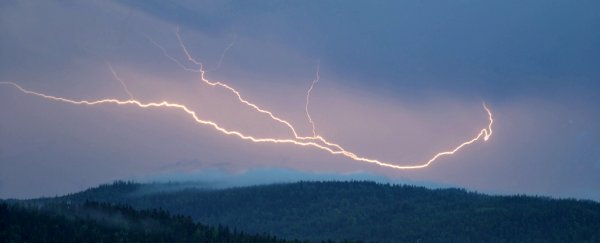The United Nation's World Meteorological Organisation (WMO) has just announced that the longest lightning strike on record was a 2007 bolt in Oklahoma that stretched 321 km (200 miles) - almost reaching from one side of the state to the other.
It was so big, in fact, that it's prompted calls for a rewrite of the official definition of a lightning strike - seeing as before this, it was assumed that lightning could travel no more than around 32 km (20 miles) from a storm.
But while the US set the record for the longest distance, France experienced the longest-lasting lightning strike ever, according to the WMO, with a flash over the Cote d'Azur region in 2012 lighting up the sky for an incredible 7.74 seconds - prior to the event, lightning was thought to max out at 1 second.
"It was a 'cloud-to-cloud' discharge," Randall Cerveny from the WMO told the AFP. The French lightning bolt also stretched an impressive (and definition-defying) 200 km (125 miles) in distance.
The team was able to determine records after years of ground-based lightning detection networks, which measure the strength and duration of lightning strikes.
But as impressive as these two events are, the World Meteorological Organisation suspects that even more extreme examples exist in nature - we just haven't had the chance to monitor them as yet.
In a paper outlining the new records, accepted for publication in the Bulletin of the American Meteorological Society, the team compares the situation to the official highest wind gust of 113.2 metres per second (253 mph), which was recorded in Australia in 1996.
But it's likely that tornadoes and hurricanes produce stronger winds than that, but without being directly monitored.
Because of the possibility for more extreme events out there, the researchers are calling for the American Meteorological Society to update their definition of lightning.
"The committee has unanimously recommended amendment of the AMS Glossary of Meteorology definition of lightning discharge as a 'series of electrical processes taking place within 1 second'," the team writes, "by removing the phrase 'within 1second' and replacing with 'continuously'."
In addition to providing a mind-boggling example of just how powerful lightning can be, the two new records also show that the potential 'danger zone' for lightning strikes is much bigger than we previously thought.
John Jensenius from the National Weather Service told Angela Fritz from The Washington Post that the new record "demonstrates the far-reaching effects of lightning, and just how far around a thunderstorm the atmosphere can be electrified".
"People need to be aware that any time a thunderstorm is in the area, there is a threat of a potentially deadly lightning strike," he added.
The National Weather Service advises that, to be safe, people stay indoors for at least 30 minutes following the last thunder rumble to avoid lightning strikes - which still kills up to thousands of people each year, particularly in developing countries. (The lightning death toll in the US has been consistently below 50 since 2000.)
In a more extreme example of how dangerous the weather event can be, 300 reindeer in Norway were killed by a single lightning strike last month.
Thanks to better lightning monitoring via satellites, scientists have also officially updated the 'lightning capital of the world' to Lake Maracaibo in Venezuela, which sees 233 lightning flashes per square kilometre each year.
Before that, the Congo Basin in Africa held the title, with an annual rate of 205.31 flashes per square kilometre.
Hopefully, as we continue to catch lightning in the act more and more often - and in increasingly better detail - we'll learn more about this beautiful phenomenon, and how to enjoy it safely.
